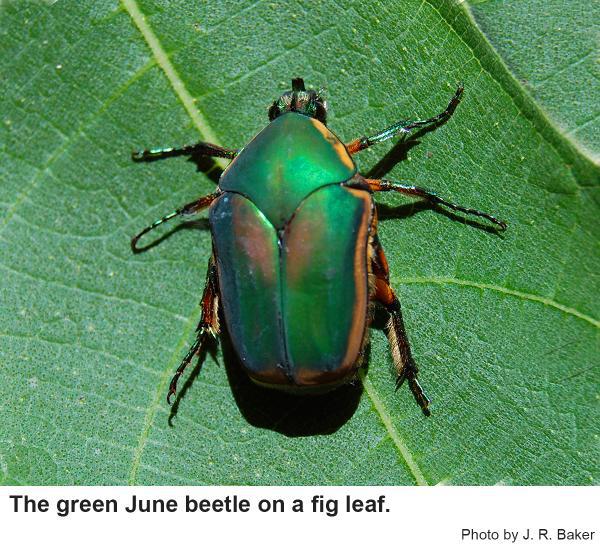Biology
The green June bug (Cotinus nitida) is an occasional pest of grapes in North Carolina. Adult beetles are almost an inch long and metallic green in color. In North Carolina, the adults emerge in late June through August to feed and search for mates. In addition to grapes, adult beetles feed on other soft, overripe fruit such as blackberries, peaches, and figs. The females lay eggs in moist organic soil. Larvae live in the soil and feed on decaying organic matter and sometimes other soil insects. The larvae overwinter underground protected by a casing of soil and pupate in May. In North Carolina, green June beetles have one generation per year.
Damage in North Carolina Grapes
Green June bugs feed on grape fruit. The beetles are most attracted to fruit that is overripe and will preferentially feed on it over less ripe fruit. Populations of green June beetles fluctuate from season to season, and damage one year does not guarantee damage the next.
Sampling and Thresholds
No economic thresholds exist for green June beetles in NC. Growers should visually inspect fruit for feeding beetles, especially if overripe fruit is present.
Management Options
Cultural Control
Cultural methods are the recommended method of controlling green June bugs. Harvesting fruit before it becomes overripe will dramatically reduce green June bug abundance and damage. For varieties that ripen around the time of peak green June bug emergence, multiple harvests may be necessary.
Conventional Insecticides
We do not recommend insecticide applications to control green June bugs in most instances. In situations where harvest is difficult to time, such as periods of frequent rain, limited insecticide applications may be helpful to protect harvestable fruit but materials effective against green June beetle also have the potential to cause non target pest outbreaks of secondary pests including two-spotted spider mites.
Refer to the North Carolina Agricultural Chemicals Manual for the most current recommendations on materials for insect control. Pesticide toxicity information for honeybees is also available in the North Carolina Agricultural Chemicals Manual.
Organic Insecticides
Organically-acceptable insecticides will generally have limited efficacy against the green June bug, and cultural controls will be more effective.
Biological Control
Naturally-occurring predatory wasps feed on green June bugs. Purchasing biological control organisms for release to control green June beetles is not recommended.
More Information
The Southern Region Small Fruit Consortium Bunch Grape IPM Guide and Muscadine IPM Guide contain regional recommendations for grape root borer management.
Publication date: May 18, 2020
N.C. Cooperative Extension prohibits discrimination and harassment regardless of age, color, disability, family and marital status, gender identity, national origin, political beliefs, race, religion, sex (including pregnancy), sexual orientation and veteran status.


